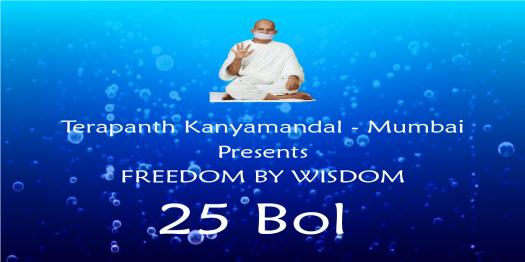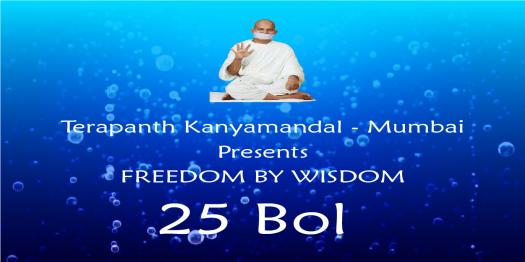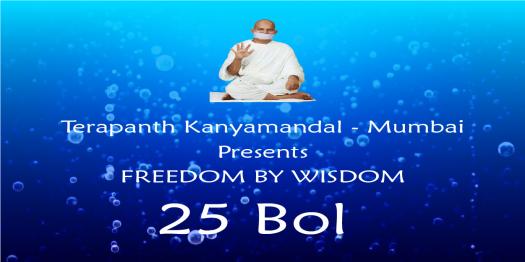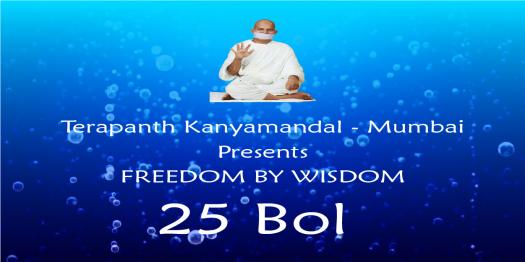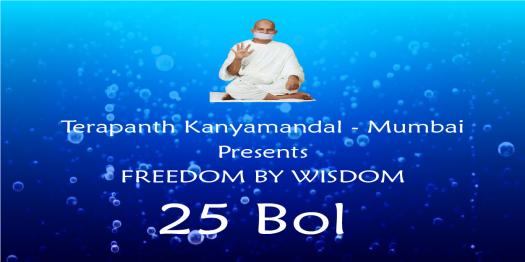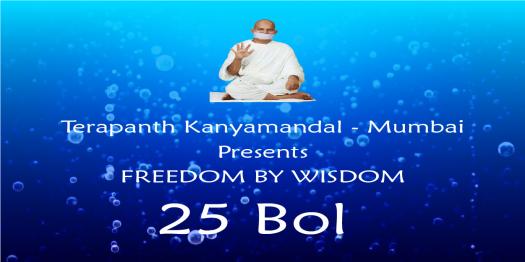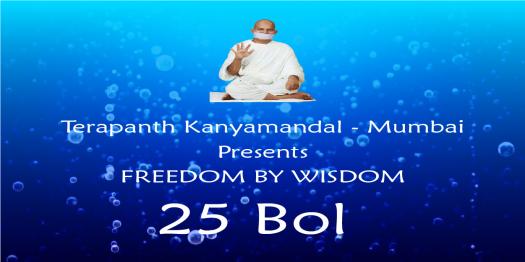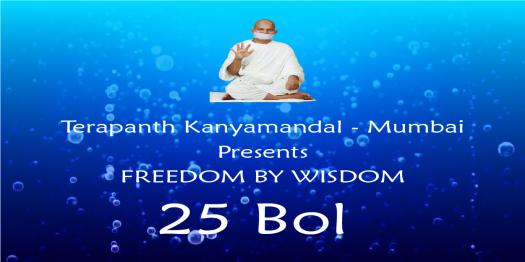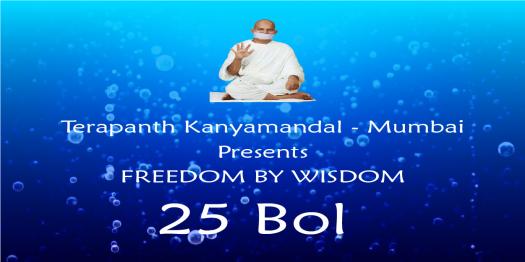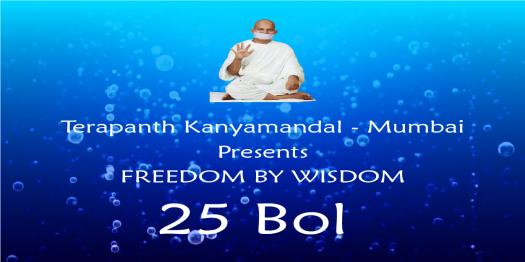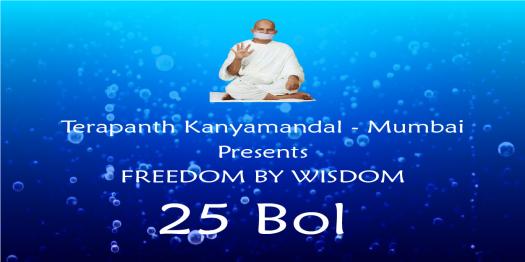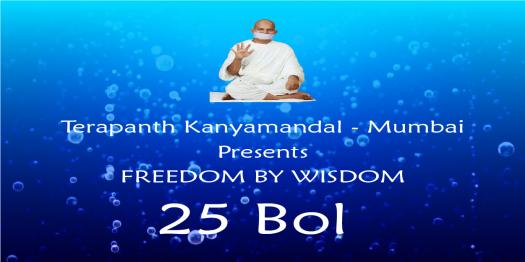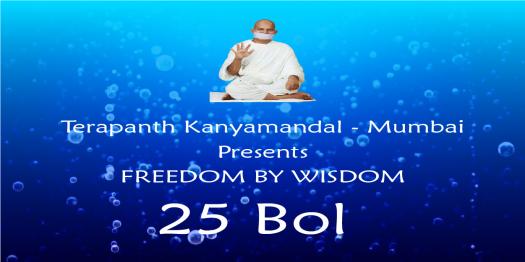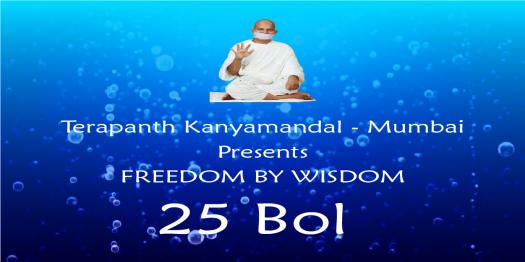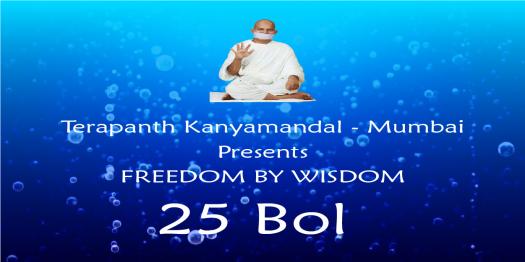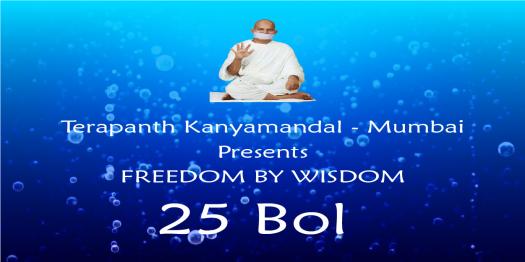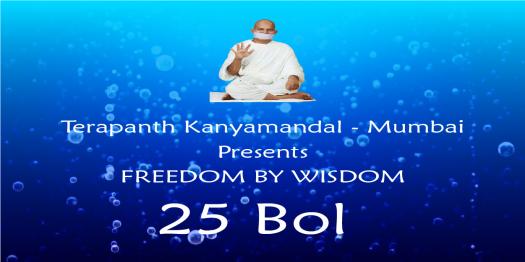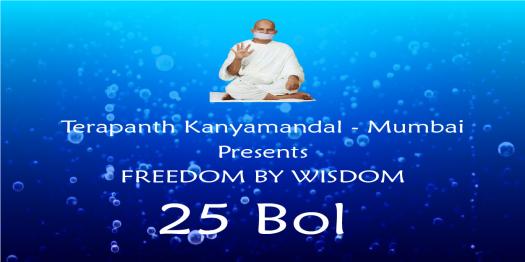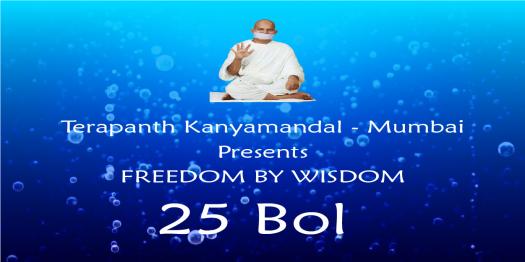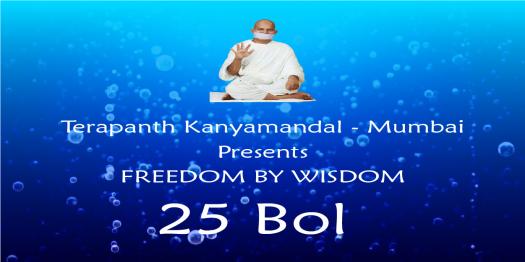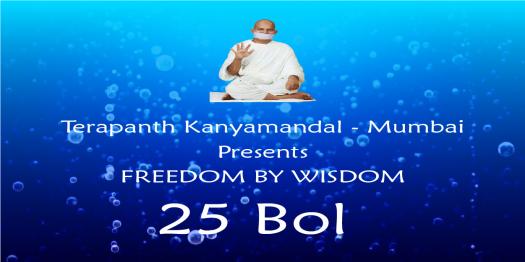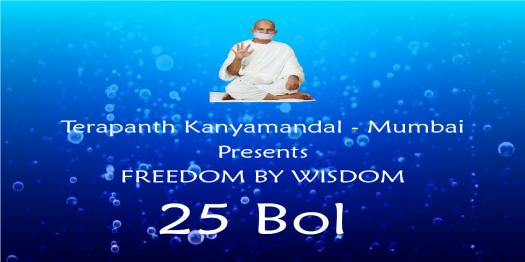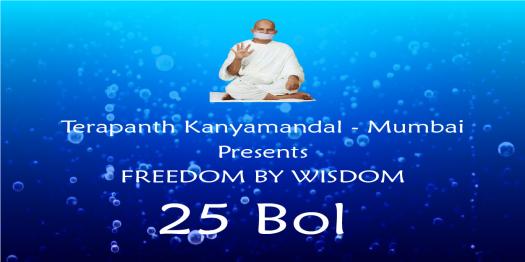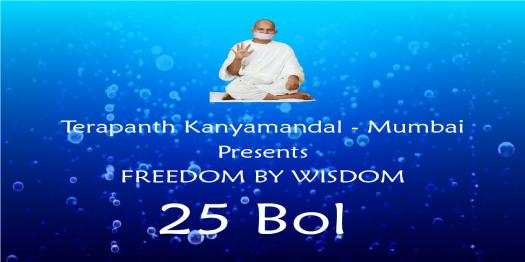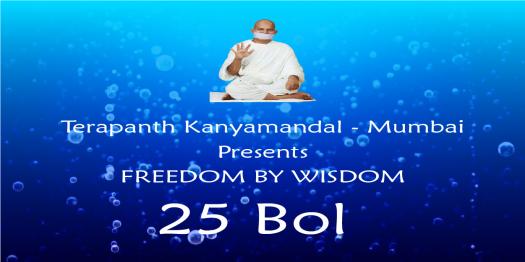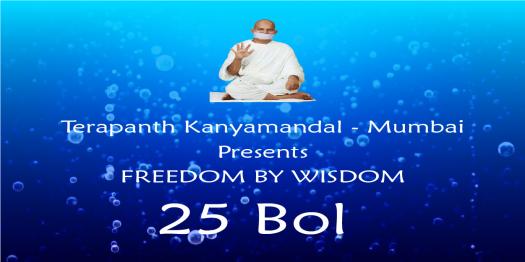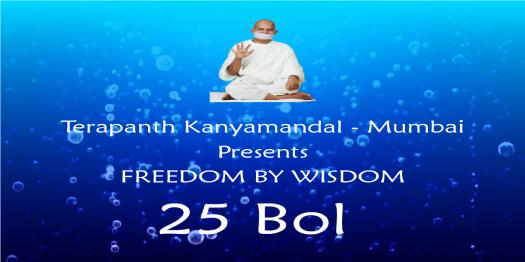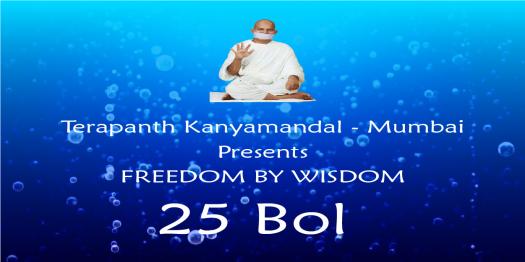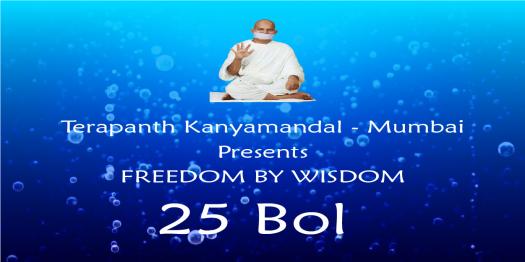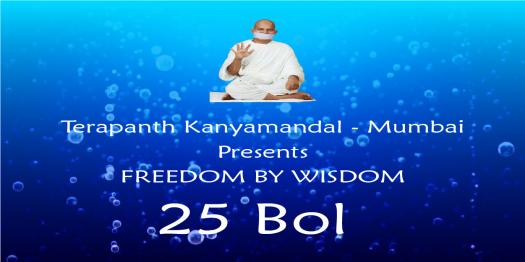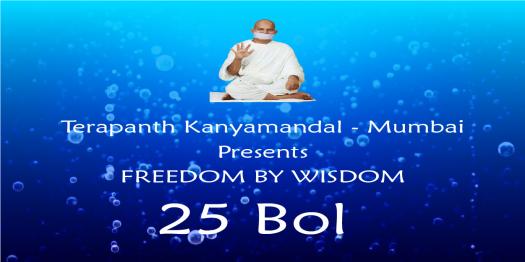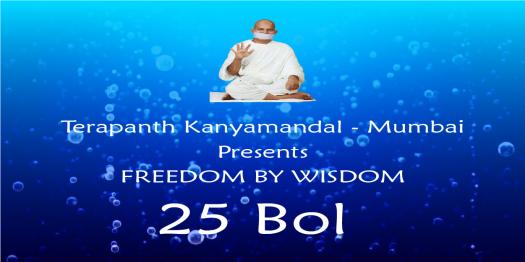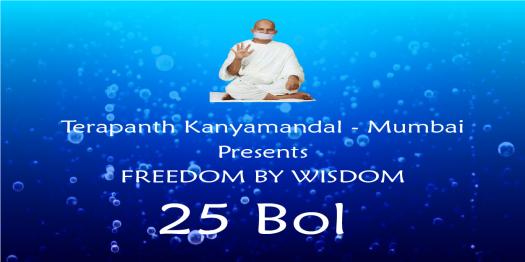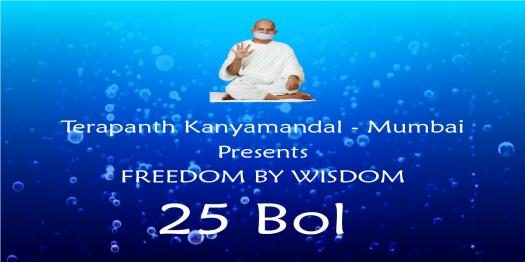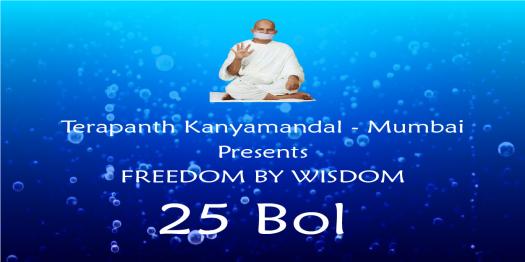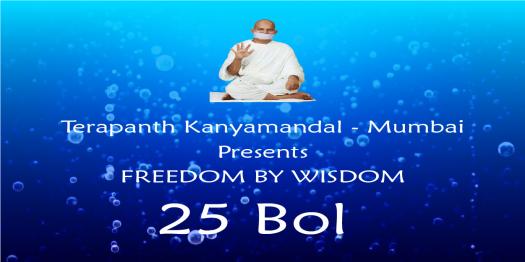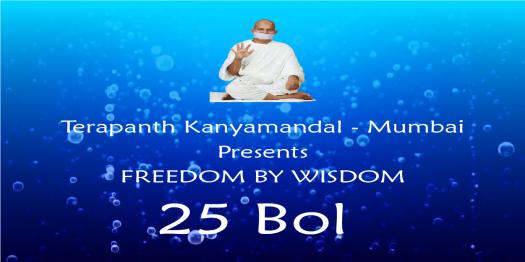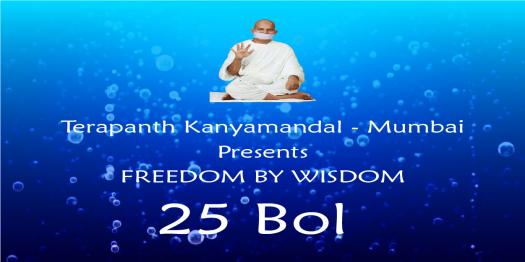Freedom By Wisdom - 25 Bol Quiz ( Blue Band)

- 1.
पॉऺंचवां बोल कोन सा है ?
- A.
शरीर पॉऺंच
- B.
पर्याप्ति छः
- C.
जाति पॉऺंच
- D.
इन्द्रिय पॉऺंच
Correct Answer
B. पर्याप्ति छःExplanation
The correct answer is "पर्याप्ति छः" because it is the only option that makes sense in the given context. The other options do not have any relevance to the question or the topic of discussion.Rate this question:
-
- 2.
मोहनीय कर्म कौन से बोल में आता है ?
- A.
12 वां
- B.
13 वां
- C.
10 वां
- D.
8 वां
Correct Answer
C. 10 वां -
- 3.
किस तत्व के अठारह भेद हैं ?
- A.
पाप तत्व
- B.
अजीव तत्व
- C.
आश्रव तत्व
- D.
संवर तत्व
Correct Answer
A. पाप तत्व -
- 4.
आठवां दंडक कोन सा है ?
- A.
दिक्कुमार
- B.
उदधिकुमार
- C.
द्वीपकुमार
- D.
वायुकुमार
Correct Answer
B. उदधिकुमार -
- 5.
देशावकाशिक व्रत कोन से बोल में आता है ?
- A.
23 वां
- B.
18 वां
- C.
22 वां
- D.
24 वां
Correct Answer
C. 22 वां -
- 6.
अभ्याख्यान पाप किस नंबर (क्रम संख्या) पर है ?
- A.
तेरहवें
- B.
चौदहवें
- C.
पंद्रहवें
- D.
सोलहवें
Correct Answer
A. तेरहवें -
- 7.
अंक २२ के कितने भांगे हो सकते हैं ?
- A.
3
- B.
1
- C.
9
- D.
4
Correct Answer
C. 9Explanation
The question asks how many ways the number 22 can be expressed as a sum of two numbers. The options given are 3, 1, 9, and 4. The correct answer is 9 because there are nine possible combinations: 1+21, 2+20, 3+19, 4+18, 5+17, 6+16, 7+15, 8+14, and 9+13.Rate this question:
-
- 8.
श्रावक के कितने व्रत होते है
- A.
5
- B.
10
- C.
12
- D.
4
Correct Answer
C. 12Explanation
There are 12 vows for a Jain layperson, known as Shravak. These vows include non-violence, truthfulness, non-stealing, celibacy, and non-possession among others. These vows are taken to purify the soul and lead a righteous and ethical life.Rate this question:
-
- 9.
पंद्रहवां बोल कोन सा हैं ?
- A.
दण्डक चौबीस
- B.
आत्मा आठ
- C.
राशि दो
- D.
दृष्टि तीन
Correct Answer
B. आत्मा आठ -
- 10.
गुणस्थान चौदह कोन सा बोल है ?
- A.
9 वां
- B.
10 वां
- C.
12 वां
- D.
11 वां
Correct Answer
D. 11 वां -
- 11.
पांच इन्द्रियों के कुल विषय हैं ?
- A.
13
- B.
12
- C.
24
- D.
23
Correct Answer
D. 23Explanation
The question is asking for the total number of subjects of the five senses. The answer is 23. However, without any context or further information, it is difficult to determine the specific subjects being referred to in this question.Rate this question:
-
- 12.
मित्यात्व के प्रकार बताने वाला बोल ?
- A.
9
- B.
17
- C.
13
- D.
7
Correct Answer
C. 13Explanation
The correct answer is 13 because it is the only odd number in the given options. All the other numbers (9, 17, and 7) are odd, while 13 is the only even number.Rate this question:
-
- 13.
सोलहवां दण्डक कोन सा है ?
- A.
पृथ्वीकाय
- B.
तेजस्काय
- C.
अप्काय
- D.
वनस्पतिकाय
Correct Answer
D. वनस्पतिकाय -
- 14.
मनुष्य पंचेन्द्रिय का दण्डक है ?
- A.
20 वां
- B.
23 वां
- C.
21 वां
- D.
17 वां
Correct Answer
C. 21 वांExplanation
The question asks about the punishment for the human senses. The term "दण्डक" refers to punishment or penalty. The correct answer is "21 वां" which means the punishment is twenty-first.Rate this question:
-
- 15.
संवर तत्व के भेद हैं ?
- A.
10
- B.
30
- C.
5
- D.
20
Correct Answer
D. 20Explanation
The given options are 10, 30, 5, and 20. Out of these options, the number 20 is the only one that can be considered as a possible answer to the question "संवर तत्व के भेद हैं ?" (What are the different types of refining elements?). The other options do not make sense in the context of the question.Rate this question:
-
- 16.
जीव तत्व के कितने भेद हैं ?
- A.
11
- B.
13
- C.
12
- D.
14
Correct Answer
D. 14Explanation
There are 14 different elements of life.Rate this question:
-
- 17.
अनशन ओर भिक्षाचरी के बीच में निर्जरा का कोनसा भेद आता है ?
- A.
ऊनोदरी
- B.
रस परित्याग
- C.
काय क्लेश
- D.
प्रतिसंलीनता
Correct Answer
A. ऊनोदरीExplanation
ऊनोदरी निर्जरा अनशन और भिक्षाचरी के बीच एक भेद है। इसका अर्थ होता है कि अनशन और भिक्षाचरी दोनों ही निर्जरा के विभिन्न प्रकार हैं, जहां अनशन निर्जरा में भोजन और पानी की आवश्यकता को त्याग करता है, वहीं भिक्षाचरी निर्जरा में वाणी की आवश्यकता को त्याग करता है। इसलिए, ऊनोदरी विकल्प सही उत्तर है।Rate this question:
-
- 18.
छठा प्राण कोन सा है ?
- A.
आयुष्य प्राण
- B.
मनोबल प्राण
- C.
वचनबल प्राण
- D.
कायबल प्राण
Correct Answer
B. मनोबल प्राण -
- 19.
काययोग के कितने प्रकार हैं ?
- A.
3
- B.
5
- C.
7
- D.
9
Correct Answer
C. 7Explanation
There are seven types of Kayayoga.Rate this question:
-
- 20.
रति- अरति पाप किस नंबर (क्रम संख्या) पर है ?
- A.
17
- B.
16
- C.
15
- D.
12
Correct Answer
B. 16 -
- 21.
सातवे बोल के कितने भेद है?
- A.
5
- B.
8
- C.
4
- D.
9
Correct Answer
A. 5Explanation
The question is asking how many different forms of the word "सातवे" (seventh) are there. The correct answer is 5 because the word "सातवे" can be written in five different ways depending on the gender and number of the noun it modifies.Rate this question:
-
- 22.
श्वासोच्छ्वास प्राण किस नंबर पर हैं ?
- A.
6
- B.
8
- C.
9
- D.
10
Correct Answer
C. 9Explanation
The question asks for the number on which the breaths and life force are located. The correct answer is 9 because in many traditional Indian systems of medicine and philosophy, including Ayurveda and Yoga, there are believed to be nine main openings or points in the body called "prana vayus" through which the breath and life force flow.Rate this question:
-
- 23.
तीसरा शरीर कौनसा है?
- A.
कार्मण शरीर
- B.
वैक्रिया शरीर
- C.
औदारिक शरीर
- D.
इनमे से कोई नहीं
Correct Answer
D. इनमे से कोई नहीं -
- 24.
अज्ञान कितने है ?
- A.
1
- B.
4
- C.
2
- D.
3
Correct Answer
D. 3Explanation
The question is asking how much ignorance there is. The answer is 3, indicating that there is a moderate amount of ignorance.Rate this question:
-
- 25.
कर्म के प्रकार बताने वाला कौनसा बोल है ?
- A.
५वाँ
- B.
१०वाँ
- C.
१५वाँ
- D.
२०वाँ
Correct Answer
B. १०वाँExplanation
The given question is asking for the ordinal number that indicates the type of karma. The correct answer is "१०वाँ" which translates to "tenth" in English. This indicates that there are ten different types of karma being discussed in the context of the question.Rate this question:
-
- 26.
नौवाँ गुणस्थान कौनसा है ?
- A.
अविरत सम्यक् दृष्टि
- B.
अप्रमत्त - संयत
- C.
निवृत्ति बादर
- D.
अनिवृत्ति बादर
Correct Answer
D. अनिवृत्ति बादरExplanation
The correct answer is "अनिवृत्ति बादर" because the ninth gunasthan is called "अनिवृत्ति बादर" which means complete cessation of all karmas. This is the highest stage of spiritual development where all karmas are completely destroyed and the soul attains liberation.Rate this question:
-
- 27.
नौ तत्वों में आश्रव तत्त्व किस नंबर पर है ?
- A.
तीसरें
- B.
पाँचवें
- C.
सातवें
- D.
नौंवें
Correct Answer
B. पाँचवें -
- 28.
पुण्य तत्त्व का अंतिम भेद कौनसा है ?
- A.
नमस्कार पुण्य
- B.
काय पुण्य
- C.
वचन पुण्य
- D.
मन पुण्य
Correct Answer
A. नमस्कार पुण्यExplanation
The correct answer is "नमस्कार पुण्य" because it is the ultimate form of virtue. "नमस्कार" means to offer respect or salutation, and "पुण्य" refers to virtue or righteousness. By offering respect or salutation, one demonstrates humility and reverence, which are considered virtuous qualities. Therefore, "नमस्कार पुण्य" represents the highest form of virtue.Rate this question:
-
- 29.
तीसरी गति कौनसी है ?
- A.
मनुष्य गति
- B.
देव गति
- C.
नरक गति
- D.
तिर्यय गति
Correct Answer
A. मनुष्य गतिExplanation
The question is asking about the third type of movement or speed. The options given are "मनुष्य गति" (human speed), "देव गति" (godly speed), "नरक गति" (hellish speed), and "तिर्यय गति" (animal speed). Among these options, "मनुष्य गति" refers to the speed or movement of humans. Therefore, the correct answer is "मनुष्य गति".Rate this question:
-
- 30.
बंध तत्व के कितने भेद है ?
- A.
2
- B.
4
- C.
6
- D.
8
Correct Answer
B. 4Explanation
The question asks about the number of divisions in the element of "bandh tattva". The correct answer is 4.Rate this question:
-
- 31.
नमस्कार पाप तत्त्व का भेद है ?
- A.
True
- B.
False
Correct Answer
B. FalseExplanation
The given statement is asking about the classification of "pap tattva" (sinful element). The correct answer is "False" which means that there is no classification or distinction of "pap tattva". This implies that all sins are considered equal and there is no hierarchy or categorization of sinful actions.Rate this question:
-
- 32.
छठा बोल शरीर पॉंच नहीं है ?
- A.
True
- B.
False
Correct Answer
A. TrueExplanation
The statement "छठा बोल शरीर पॉंच नहीं है ?" translates to "The sixth sense is not a punch to the body?" The correct answer "True" implies that the sixth sense is not a physical punch to the body.Rate this question:
-
- 33.
घ्राण इन्द्रिय पाँच इन्द्रियों में से तीसरी इन्द्रिय है ?
- A.
True
- B.
False
Correct Answer
A. TrueExplanation
The statement is true because the sense of smell is considered as the third sense organ among the five sense organs. The other four sense organs are the eyes (sense of sight), the ears (sense of hearing), the tongue (sense of taste), and the skin (sense of touch).Rate this question:
-
- 34.
नौं तत्त्व के एक सौ सोलह भेद है ?
- A.
True
- B.
False
Correct Answer
B. FalseExplanation
The statement is asking if there are 116 differences in the nine elements. Since the answer is False, it implies that there are not 116 differences in the nine elements.Rate this question:
-
- 35.
वचन निग्रह आश्रव तत्व का भेद है ?
- A.
True
- B.
False
Correct Answer
B. FalseExplanation
The statement "वचन निग्रह आश्रव तत्व का भेद है?" is asking whether there is a distinction between singular and plural in the concept of "nigrah aashrav tattva". The correct answer is False, indicating that there is no such distinction.Rate this question:
-
- 36.
पुद्गलास्तिकाय के कितने भेद होते हैं?
- A.
चार
- B.
पाँच
Correct Answer
A. चारExplanation
पुद्गलास्तिकाय के चार भेद होते हैं:
१. स्पर्श: ठोस, तरल, गैस, ऊर्जा, गर्म, ठंडा २. रस: मीठा, खट्टा, कड़वा, तीखा, कसैला ३. गंध: सुगंध, दुर्गंध ४. वर्ण: रंग, आकार
ये चारों भेद पुद्गल द्रव्य के गुण हैं और इन्हीं के आधार पर पुद्गलास्तिकाय की पहचान होती है।Rate this question:
-
- 37.
लेश्या आठ हैं
- A.
True
- B.
False
Correct Answer
B. FalseExplanation
The statement "लेश्या आठ हैं" translates to "Leshya is eight." Since "Leshya" is a proper noun and cannot be a number, the statement is incorrect. Therefore, the correct answer is "False."Rate this question:
-
- 38.
तिर्यंच पंचेन्द्रिय का दण्डक इक्कीसवां हैं ?
- A.
True
- B.
False
Correct Answer
B. FalseExplanation
The statement in the question is asking if the "dandak" of the "tiryancha panchendriya" is the "ikkeesvaan" (twenty-first) one. Since "ikkeesvaan" means twenty-first, and the question is asking if the "dandak" is the twenty-first one, the correct answer is False.Rate this question:
-
- 39.
ध्यान चार वाला बोल उन्नीसवां बोल हैं
- A.
True
- B.
False
Correct Answer
A. TrueExplanation
The statement in Hindi says that the "Dhyān chār vālā bol" is the "Unnīsawān bol". This implies that the "Dhyān chār vālā bol" is the nineteenth statement. Since the answer is "True", it means that the given statement is correct and the "Dhyān chār vālā bol" is indeed the nineteenth statement.Rate this question:
-
- 40.
साधु के पाँच महाव्रत हैं ?
- A.
True
- B.
False
Correct Answer
A. TrueExplanation
The statement "साधु के पाँच महाव्रत हैं?" translates to "A saint has five great vows?" The correct answer is "True" because in Jainism, a saint is expected to follow five major vows known as Mahavratas. These vows include non-violence, truthfulness, non-stealing, celibacy, and non-attachment.Rate this question:
-
- 41.
निर्जरा तत्त्व के बारह भेद हैं ?
- A.
True
- B.
False
Correct Answer
A. TrueExplanation
The statement in the question is asking whether there are twelve different aspects of the nirjara principle. The correct answer is "True" because there are indeed twelve different aspects or divisions of the nirjara principle.Rate this question:
-
- 42.
तेरहवां बोल दस प्रकार के मिथ्यात्व ?
- A.
True
- B.
False
Correct Answer
A. TrueExplanation
The given question is in Hindi and it asks about the thirteen types of falsehood. The correct answer is "True" which means that there are indeed thirteen types of falsehood. However, without further context or information, it is not possible to provide a detailed explanation of the thirteen types of falsehood.Rate this question:
-
- 43.
इक्कीसवां बोल ?
- A.
भांगा 49
- B.
राशि दो
- C.
दृष्टि तीन
- D.
जाति पांच
Correct Answer
B. राशि दो -
- 44.
परिहार विशुद्धि चारित्र किस नंबर पर आता है ?
- A.
3
- B.
5
- C.
2
- D.
1
Correct Answer
A. 3Explanation
The answer is 3 because परिहार विशुद्धि चारित्र is a term used in the context of Jainism, specifically referring to the purification of one's character. In Jainism, there are six essential duties or actions, known as Avashyakas, that a person must perform to attain liberation. परिहार विशुद्धि चारित्र is the third Avashyaka, which emphasizes the need to eliminate all negative qualities and attachments from one's character in order to achieve spiritual purity.Rate this question:
-
- 45.
चारित्र कितने होते हैं ?
- A.
4
- B.
6
- C.
7
- D.
5
Correct Answer
D. 5Explanation
The question is asking how many characters there are. The correct answer is 5, which means there are 5 characters.Rate this question:
-
- 46.
अंक 32 का भांगा ?
- A.
4
- B.
3
- C.
2
- D.
1
Correct Answer
B. 3Explanation
The question is asking for the "भांगा" (broken) form of the number 32. Out of the given options, the number 3 is the only one that is not broken. Therefore, the correct answer is 3.Rate this question:
-
- 47.
क्या अंक 11 का भांगा 9 हैं ?
- A.
True
- B.
False
Correct Answer
A. TrueExplanation
The given statement "क्या अंक 11 का भांगा 9 हैं ?" translates to "Is the remainder of dividing 11 by 9 zero?" In mathematics, when we divide 11 by 9, the remainder is indeed zero. Therefore, the answer is true.Rate this question:
-
- 48.
ज्योतिष - देवों का दण्डक कोनसा हैं ?
- A.
तेईसवां
- B.
इक्कीसवां
- C.
दसवां
- D.
छठा
Correct Answer
A. तेईसवां -
- 49.
काल के कितने भेद हैं ?
- A.
5
- B.
4
- C.
2
- D.
1
Correct Answer
D. 1Explanation
The question asks about the number of divisions of time. The correct answer is 1, indicating that there is only one division of time, which is the present moment or the current time.Rate this question:
-
- 50.
अयोग संवर तत्व का भेद हैं ?
- A.
True
- B.
False
Correct Answer
A. TrueExplanation
The given question asks about the different types of Ayoga Sanvar Tatva. The correct answer is "True" which implies that there are indeed different types of Ayoga Sanvar Tatva. However, without further context or information provided, it is difficult to determine the specific types of Ayoga Sanvar Tatva that are being referred to in this question.Rate this question:
-
Quiz Review Timeline +
Our quizzes are rigorously reviewed, monitored and continuously updated by our expert board to maintain accuracy, relevance, and timeliness.
-
Current Version
-
Oct 23, 2024Quiz Edited by
ProProfs Editorial Team -
Oct 21, 2018Quiz Created by
Deepanshi Jain
 Back to top
Back to top



